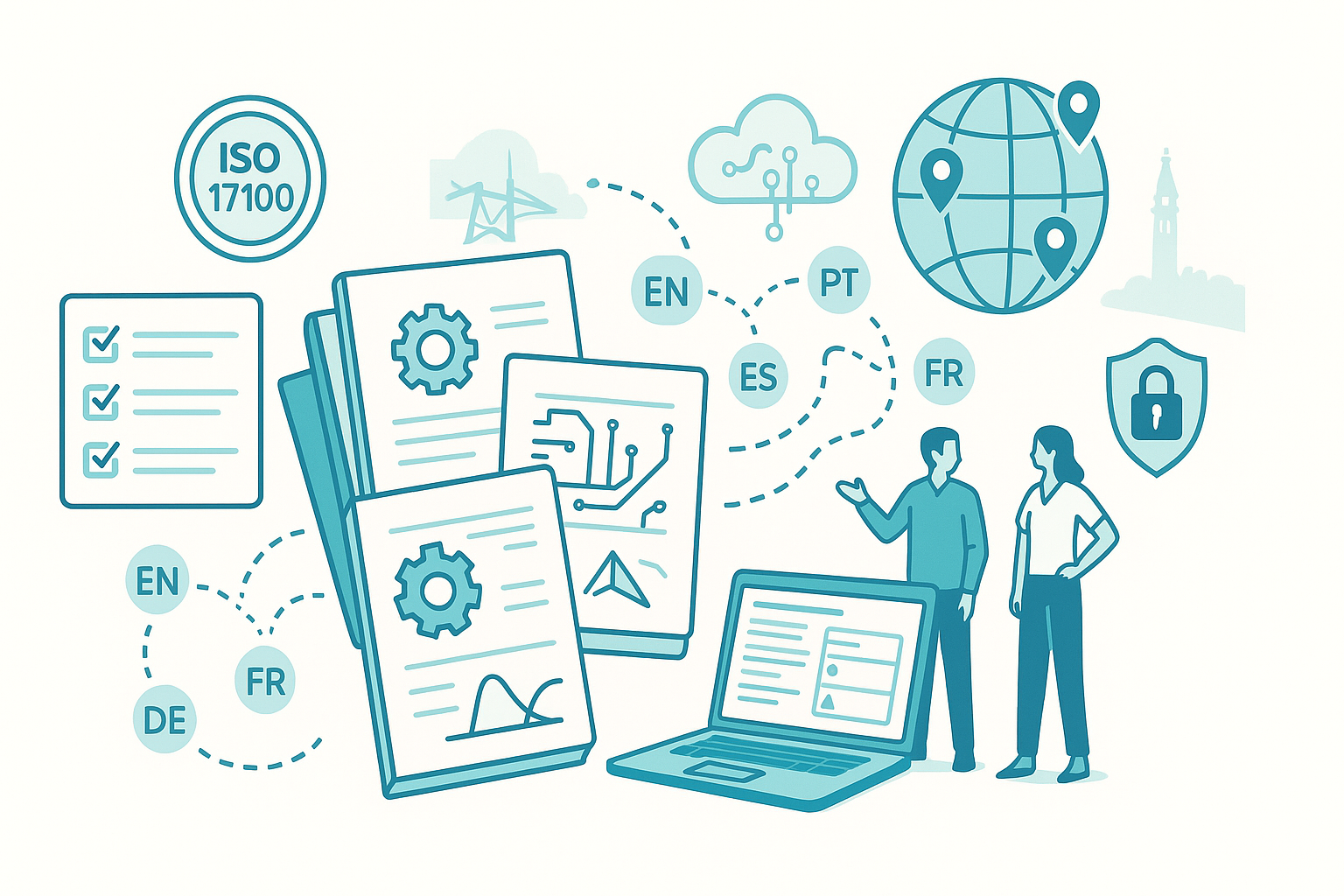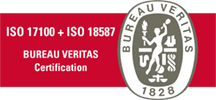A translation company for technical projects: what to expect
Translation company for technical projects: what to expect
A translation company turns complex technical content into clear, accurate documentation for every market. Pick one that pairs expert linguists with robust QA and compliance.

Table of Contents
Why a translation company matters in technical work
Technical content has a job to do: enable safe use, reduce support tickets, and protect your brand. A translation company with proven technical depth reduces risk by aligning language with engineering intent, not just literal wording.
Beyond manuals and datasheets, think user interfaces, CAD notes, safety labels, and training content. Each format introduces constraints—character limits, symbols, units—that require process and tooling to keep everything consistent across languages.
An experienced partner also integrates with your product lifecycle. From pre-release terminology work to post-launch updates, they create a repeatable pipeline that avoids rework and safeguards institutional knowledge across teams. Explore how we operate across industries in We translate the world.
How to brief a translation company for technical content
Give context early. Share reference builds, screenshots, glossary candidates, and approved samples. Provide SME contacts for questions and define what “good” looks like: style, tone, units, and regulatory scope.
Ask for a draft terminology list and review it with your engineers. Locking key terms up front prevents downstream churn. If your project includes certifications or notarizations, clarify whether you’ll need certified translations and in which jurisdictions. A strong partner will advise you on the right path and documentation.
Link the brief to service lines you may need later—such as technical translation services, legal translation for contracts and warranties, or broader translation services for marketing assets—so your provider can architect a cohesive workflow from day one.
How a translation company builds accuracy at scale
Accuracy starts with people. Technical translators should demonstrate field experience—mechanical, electrical, software, life sciences—and work under a second-person review. Look for documented reviewer qualifications and continuous skills development, supported by ongoing training.
Then comes process. Expect version control, bilingual QA, terminology governance, and change logs. Providers who operate under recognized standards (e.g., requirements aligned with ISO 17100 — Translation services) formalize steps like translator qualifications, review, and project records to improve repeatability.
Tooling amplifies quality. Translation memories reduce cost and speed updates; termbases protect critical wording; connectors synchronize with your CMS or code repo. The best setups keep engineers, writers, and linguists in a tight feedback loop. Our culture of continuous improvement makes those loops measurable.
Speed without sacrificing quality
Fast doesn’t mean sloppy. Your partner should right-size effort by content type. Stable, repetitive strings flow through optimized translation memories; novel, high-risk content gets extra human review.
Ask for a service model that maps content risk to workflow. For example:
- Low risk: standard translation + light review
- Medium risk: translation + independent review + terminology check
- High risk: translation + senior review + functional testing in-context
Continuous improvement should be explicit—documented defects, root-cause analysis, and preventive actions. Look for a culture of ongoing training and continuous improvement that shows in their metrics and retrospectives. For critical deliverables, ask about a zero errors commitment and how it’s enforced.
Regulatory and terminology compliance
In regulated domains (e.g., medical devices), getting terminology wrong can block market access. Your translation company should demonstrate familiarity with EU MDR documentation patterns and official guidance, and know when to escalate content to subject-matter experts. Start with the MDCG guidance library to align expectations.
For electrotechnical content, maintain alignment with authoritative vocabularies to avoid ambiguity (think “attenuation,” “insertion loss,” or “bandwidth”). Using references like the IEC Electropedia helps standardize term choices across families of products.
Terminology isn’t set-and-forget. Expect periodic term audits, stakeholder sign-off, and controlled updates. Your provider should publish the termbase to your teams and wire it into authoring tools so upstream writers use the same language.
What to look for in your first project
Start with a concise pilot. Choose materials that touch your key term families and formats—UI strings, a chapter of the manual, and a support article. Define success criteria: defect thresholds, schedule, reviewer effort, in-context rendering, and reusability of assets.
During the pilot, evaluate:
- Service scope fit. Do they cover technical, legal, and certified needs if required later?
- QA discipline. Do they run bilingual checks, terminology validations, and style adherence?
- Risk controls. Do they have a zero errors commitment and the escalation paths to back it up?
- Scalability. Can they plug into your translation services stack and CI/CD?
Embed links and artifacts in the deliverable: termbase snapshots, translation memory seeds, change logs, and reviewer notes. These assets reduce cost on subsequent releases and make quality measurable rather than subjective.
To make handover painless, ask for a one-page “How we work” sheet that summarizes environments, contacts, SLAs, and conventions (dates, decimals, units). That document becomes the anchor for onboarding future teams and vendors.
FAQ
Q1. How do I evaluate a translation company for highly technical content?
Begin with people and proof. Request CVs of translators and reviewers with domain experience—mechanical, electrical, software, or life sciences. Ask for anonymized samples that show how they handle units, warnings, and UI constraints. Confirm that a second linguist independently reviews translations and that the provider documents corrective actions when issues arise.
Next, probe process and governance. Do they operate under recognized requirements for translation services, with written procedures for qualification, review, and record-keeping? How are terminology and translation memories managed, and who approves changes? Finally, ask to see metrics after a pilot: error rates by category, reuse rates from translation memory, and cycle times. The combination of evidence, process maturity, and measurable outcomes is a reliable predictor of long-term performance. Review any stated zero errors commitment and how it translates into SLAs.
Q2. What’s the best way to brief technical translation to avoid rework?
Treat the brief as a specification. Provide the source files, reference builds or screenshots, and any existing style guides. Include unit conventions (e.g., SI), capitalization rules, and product names that must remain untranslated. Supply glossary candidates and identify your SMEs for sign-off.
Set success criteria in advance: target delivery dates, acceptable defect thresholds, and which content requires in-context review (UI, labels, packaging). If regulation applies, cite the exact guidance and notify the provider of any notified-body expectations. For medical projects, align early with MDCG guidance so document structure and terminology meet market requirements.
Q3. How should technical terminology be governed across product lines?
Start with a term discovery pass on your core documents, then validate with engineers. Build a termbase with preferred terms, forbidden terms, part-of-speech notes, and usage examples. Publish the termbase and integrate it into both authoring and translation tools so the guidance is enforced where content is created.
Review terminology on a cadence—quarterly for active products—to align with new features and standards. Use authoritative sources to resolve disputes (for example, the IEC Electropedia for electrotechnical terms). When changes occur, communicate them via release notes so upstream authors and downstream translators update in lockstep.
Q4. How do standards and regulations affect technical translation workflows?
Standards shape the checks and records that surround each job. Requirements aligned with ISO 17100 formalize translator qualifications, review stages, and project documentation, which supports consistency and auditability across releases. In regulated spaces such as EU medical devices, MDCG guidance informs document structure, labeling, and terminology; translation must respect those patterns to pass scrutiny.
Practically, this means gating high-risk content behind extra reviews, maintaining auditable change logs, and keeping proof of qualified personnel. It also means using official terminology sources where available. The right partner will map these obligations into a clear workflow so you can demonstrate due diligence to auditors and customers.
Image Suggestion (not published)
- Concept: Close-up of an engineer and a linguist collaborating over a technical schematic on a large screen; neutral office setting; soft natural light; landscape.
- Alt text: Engineer collaborating with a translation company on technical documentation
- Suggested filename: translation-company-technical-collaboration.jpg
Links:
- Internal
- Translation services → https://www.m21global.com/en/translation-services/
- We translate the world → https://www.m21global.com/en/we-translate-the-world/
- Ongoing training → https://www.m21global.com/en/ongoing-training/
- Continuous improvement → https://www.m21global.com/en/continuous-improvement/
- Zero errors commitment → https://www.m21global.com/en/zero-errors-total-satisfaction-commitment/
- Certified translations → https://www.m21global.com/en/translation-services/certified-translations/
- Technical translation services → https://www.m21global.com/en/translation-services/technical-translation/
- Legal translation → https://www.m21global.com/en/translation-services/legal-translation/
- Translation services (second mention) → https://www.m21global.com/en/translation-services/
- External (embedded):
A) ISO 17100 — Translation services → https://www.iso.org/standard/59149.html
B) EU Medical Devices — MDCG guidance → https://health.ec.europa.eu/medical-devices-sector/new-regulations/guidance-mdcg-endorsed-documents-and-other-guidance_en
C) IEC Electropedia → https://iec.ch/electropedia

